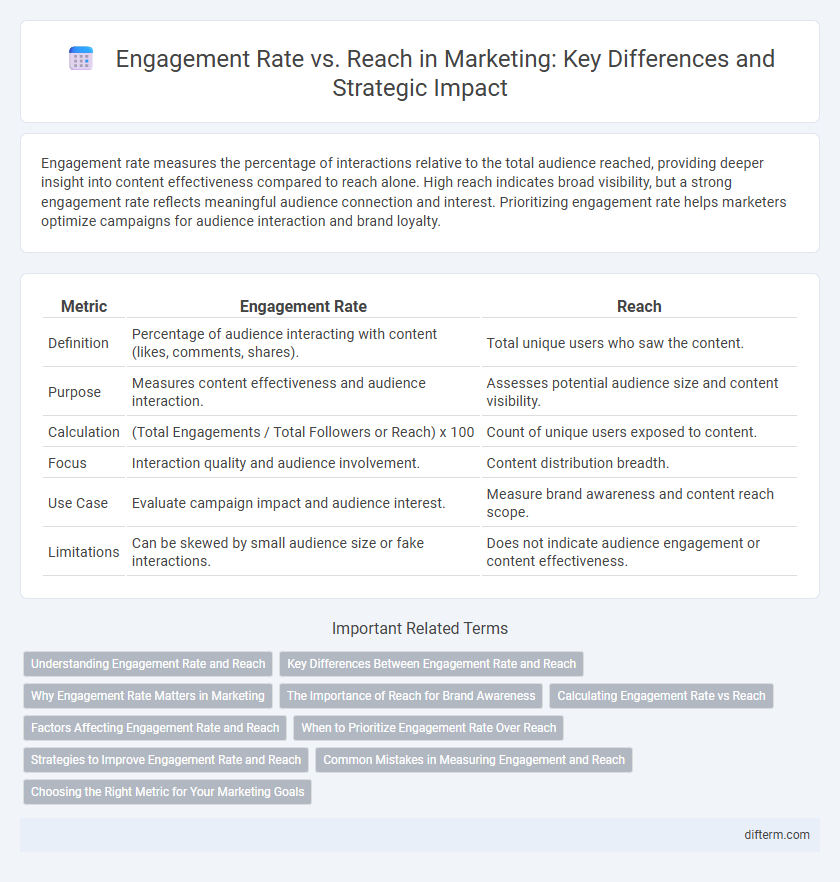Engagement rate measures the percentage of interactions relative to the total audience reached, providing deeper insight into content effectiveness compared to reach alone. High reach indicates broad visibility, but a strong engagement rate reflects meaningful audience connection and interest. Prioritizing engagement rate helps marketers optimize campaigns for audience interaction and brand loyalty.
Table of Comparison
| Metric | Engagement Rate | Reach |
|---|---|---|
| Definition | Percentage of audience interacting with content (likes, comments, shares). | Total unique users who saw the content. |
| Purpose | Measures content effectiveness and audience interaction. | Assesses potential audience size and content visibility. |
| Calculation | (Total Engagements / Total Followers or Reach) x 100 | Count of unique users exposed to content. |
| Focus | Interaction quality and audience involvement. | Content distribution breadth. |
| Use Case | Evaluate campaign impact and audience interest. | Measure brand awareness and content reach scope. |
| Limitations | Can be skewed by small audience size or fake interactions. | Does not indicate audience engagement or content effectiveness. |
Understanding Engagement Rate and Reach
Engagement rate measures the percentage of audience interactions such as likes, comments, and shares relative to total reach, indicating content effectiveness and audience involvement. Reach quantifies the total number of unique users who have seen a marketing message or campaign, reflecting potential exposure but not direct interaction. Understanding the distinction between engagement rate and reach helps marketers optimize content strategies by balancing broad visibility with meaningful audience connection.
Key Differences Between Engagement Rate and Reach
Engagement rate measures the percentage of interactions (likes, comments, shares) relative to the total audience, highlighting how actively users connect with content. Reach indicates the total number of unique users who have seen the content, emphasizing potential audience size without reflecting interaction quality. Understanding these metrics helps marketers balance content visibility with audience engagement for more effective campaigns.
Why Engagement Rate Matters in Marketing
Engagement rate measures the level of interaction consumers have with marketing content, providing deeper insights than reach alone, which only accounts for the number of people exposed to the message. High engagement rates indicate strong audience interest and effectiveness in driving actions such as likes, shares, comments, and conversions. Marketers prioritize engagement rate to optimize campaigns, improve customer loyalty, and maximize return on investment by targeting users actively responding to content.
The Importance of Reach for Brand Awareness
Reach measures the total number of unique users exposed to your marketing content, playing a crucial role in expanding brand awareness. A broad reach ensures your message penetrates diverse audience segments, increasing the potential for recognition and top-of-mind recall. While engagement rate gauges interaction quality, prioritizing reach helps establish a strong brand presence in competitive markets.
Calculating Engagement Rate vs Reach
Engagement rate is calculated by dividing total interactions (likes, comments, shares) by the total number of followers or reach, then multiplying by 100 to express it as a percentage. Reach measures the number of unique users who have seen a post, whereas engagement rate reflects the quality of interaction relative to that audience size. Marketers use engagement rate to evaluate content effectiveness beyond mere visibility, offering deeper insights into audience involvement and campaign performance.
Factors Affecting Engagement Rate and Reach
Engagement rate is influenced by factors such as content relevance, audience demographics, posting frequency, and platform algorithms that prioritize user interaction. Reach depends on variables like follower count, content type, timing of posts, and paid promotion strategies that expand visibility beyond existing followers. Both metrics are essential for assessing campaign performance, with engagement rate reflecting audience interaction quality and reach indicating overall exposure.
When to Prioritize Engagement Rate Over Reach
Prioritize engagement rate over reach when measuring campaign effectiveness in building strong customer relationships and brand loyalty. High engagement rates indicate meaningful interactions such as likes, comments, and shares, which drive conversion and enhance organic growth. Focusing on engagement helps marketers assess the quality of audience interaction, making it crucial for content-driven strategies and community building.
Strategies to Improve Engagement Rate and Reach
Boosting engagement rate requires creating high-quality, relevant content that encourages interaction through comments, shares, and likes, while leveraging personalized calls-to-action boosts audience participation. Expanding reach can be achieved using targeted advertising, influencer collaborations, and optimizing posting times based on audience analytics to maximize visibility. Combining these strategies enhances overall social media performance by attracting a broader audience and fostering deeper connections with followers.
Common Mistakes in Measuring Engagement and Reach
Marketers often confuse engagement rate and reach by failing to account for the difference between total interactions and the audience size exposed to content. Common mistakes include measuring engagement without considering reach variability across platforms, leading to skewed performance insights. Accurate analysis requires segregating metrics to reflect genuine audience interaction versus mere content visibility.
Choosing the Right Metric for Your Marketing Goals
Engagement rate measures the percentage of interactions (likes, comments, shares) relative to the audience size, while reach quantifies the total number of unique viewers exposed to your content. Selecting the right metric depends on your marketing objectives: use engagement rate to gauge content effectiveness and audience connection, and prioritize reach to assess brand awareness and message distribution. Aligning your choice with specific goals ensures accurate performance evaluation and more strategic resource allocation.
Engagement rate vs reach Infographic

 difterm.com
difterm.com